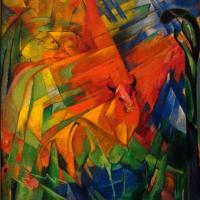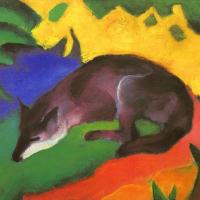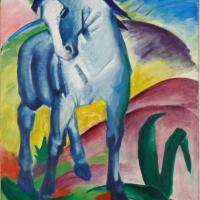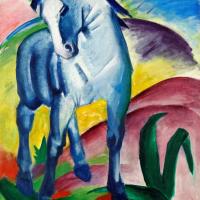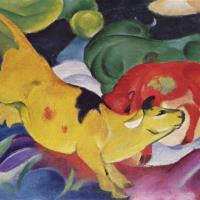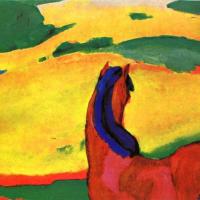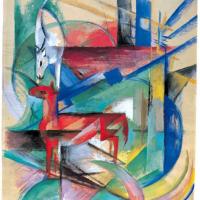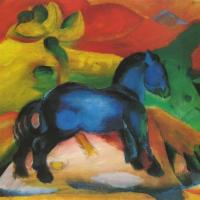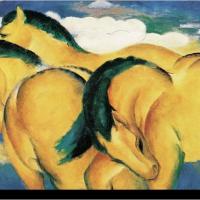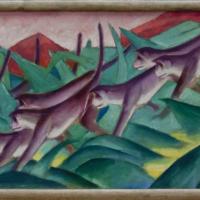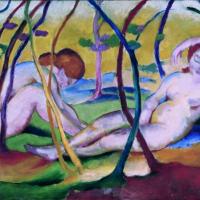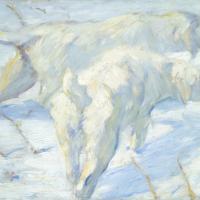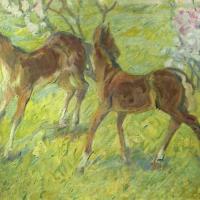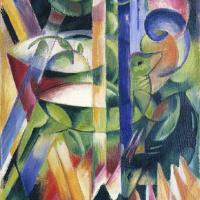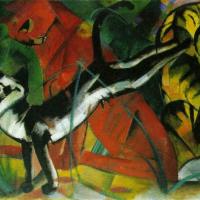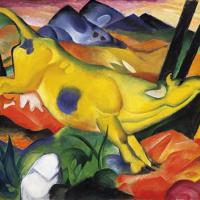Franz Marc
Animals In A Landscape
$510.00
Blue Fox
$450.00
Blue Horse
$450.00
Blue Horse
$450.00
Cows Red Green Yellow
$450.00
Horse In A Landscape
$450.00
Horses at Pasture
$450.00
Kleine Steinstudie
$450.00
Landscape With Animals
$450.00
Little Blue Horse
$450.00
Little Yellow Horses
$450.00
Monkey Frieze
$450.00
Nu Au Chat
$510.00
Nudes Under Trees
$450.00
Red Deers
$510.00
Siberian Dogs In The Snow
$450.00
Springende Fohlen
$450.00
Te Rerioa ( The Dream )
$450.00
The Little Mountain Goats
$450.00
The Sheep
$450.00
Three Cats
$450.00
Yellow Cow
$450.00
Yellow Cow
$450.00
Franz Marc
Franz Marc (1880-1916)
Franz Marc , born on February 8 , 1880 in Munich and died on March 4 , 1916 in Braquis , near Verdun , is one of the main representatives of German Expressionism. Animal painter, engraver, pastellist, watercolourist, lithographer, writer, he is part of the group Le Cavalier bleu.
Franz Moritz Wilhelm is born on February 8 , 1880 in Munich , a father painter and teacher, Wilhelm Marc, and Sophie Maurice. His Protestant education gives him a very open perspective on life. He will take different orientations, especially those of pastor or philosopher, before deciding for painting.
He entered the Munich Academy of Fine Arts, but the atmosphere was too stuffy for him and he would not stay there. He met several animal painters in 1905, including Jean-Bloé Niestlé (de) . Animals become his favorite subject. He made his first sketches of horse since this year. He met Marie Schnür , painter, whom he married in 1907 , adopting the son of this one, Klaus, which she had with Angelo Jank. He separates from his wife and then marries the painter Maria Franck , in 1913.
In 1907 , he rediscovers Paris (after a first stay in his youth) and the art of Van Goghand Gauguin . His palette became clearer, and in 1909 , thanks to his meeting with August Macke , he began to make himself known and made contact with many artists, as well as with the collector Bernhard Koehler . He moved, from 1910 , to Indersdorf , near Dachau.
In 1911 , he met Wassily Kandinsky with whom he created Der Blaue Reiter , a gathering of avant-garde painters. He abandons outdoor painting and his palette becomes more and more subjective. He began to paint, this year, his famous Blue Horse that inspired the title of the famous almanac Le Cavalier blue , a founding work of the group of artists he fathered. Then in 1912 , influenced by an exhibition devoted to Italian Futurism and by the paintings of Robert Delaunay , he turned to abstraction, his first work entirely of this style being Composition I , painted in December 1913.
In 1914 , he volunteered on the front where he still works in a small notebook and delights in abstract drawing. He was hit by a shrapnel during a reconnaissance ride and died in March 1916 in Braquis , near Verdun , without having really completed his journey. He will be buried temporarily in Gussainville , then in Kochel am See , district of Bad Tölz-Wolfratshausen in Bavaria, where is established a museum dedicated to him.
It is divided into three stages ranging from figurative to abstract. The part of his best known work is devoted to animal representations (mainly horse), where his theme is the life force of nature. It associates with the animal qualities - the good, the virgin, the beautiful and the true - that it does not meet in the man. It obscures all human representation for the benefit of the animal and the landscape is only the living space in which the animal evolves. He tries to paint the way the animal sees the world by a formal and chromatic simplification of things to represent "the absolute being". He attributes to each color a meaning; blue for the masculine austere and the spiritual; yellow for the feminine, sweet and cheerful, and red as the color of the violence fought by the first two.
His journey from the figurative to the abstract is done in a very progressive way - purification of the lines, background of the painting no longer representing a landscape but colored solid areas, then release of the color of the main subject ( Blue horse ) with geometric simplification - between 1903 to 1914, which will have been a long journey (11 years) compared to his short life (36 years).
Several German cities have Mark streets: Fulda , Hamburg , Wolfsburg , Oldenburg , Puchheim, Vechta , Elmshorn , Heidelberg , Kochel am See , Cologne , Leverkusen , Sindelsdorf and Munich . The Deutsche Bundespost published the February 15 , 1974 a stamp worth 30 pfennigs reproducing the Roten Rehen painting.
The Ruhmeshalle in Munich exhibits a bust of Mark.
On October 13, 2000, an asteroid discovered in 1991 was named Franz Marc: 15282 Franzmarc (1991 RX4).
A plaque is dedicated to Gussainville, the only plaque in France dedicated to a German soldier.
On 9 February 2012, Deutsche Post issued a stamp with a face value of 145 euro cents.
In 2014, to mark the 100 th anniversary of the death of August Macke , the Kunstmuseum Bonn opened the exhibition "August Macke and Franz Marc. An artistic friendship. It presents for the first time the 200 or so paintings concerning the artistic relationship between the two painters.
In February 2008, the Horses in Grass III painting was sold for a record € 16.5 million at Sotheby's in London, double the estimated price. The buyer remained anonymous.
In June 2009, one of Franz Marc's last Impressionist paintings, Jumping Horses , also from 1910, reached 4.4 million euros at Christie's , slightly less than the estimated price.


